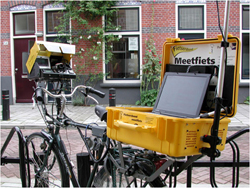Is cycling good for city cyclists?
The 'Visualisation of the exposure of cyclists to traffic on roads' (Vector) projectsought to address the issue of cyclists' exposure to traffic exhaust. The approach was to assess and demonstrate actual exposure to traffic-related fine particles (PMx) in various European cities using a novel environmental monitoring tool. The latter combines real-time measurements and video-recording (RTV) for the production of 'real-time visualisations' that clearly show exposure in different traffic situations. Project partners set up and developed a measurement technique, using a condensation particle counter and dust trak for particle measurements. A small finger camera and global positioning system (GPS) were obtained, and integration of measurement data and video recordings was tailored to project goals. A measurement bike was also set up with all necessary equipment, and the measurement set up was put through a number of test runs for further fine-tuning. Following measurement campaigns in 4 cities, data were analysed and major conclusions drawn up. The latter relate to exposure-modifying factors such as weather, the design of the city, car parks, disturbing sources of particles such as fires, local cycling infrastructure and placement of the measurement equipment. Results revealed that, among other factors, cycling lanes distanced from busy roads significantly reduced exposure. Also, relatively old diesel vehicles or two-stroke engine vehicles, such as mopeds, significantly increase exposure. The weather was found to be a major influence, and highest exposures to ultrafine particles are found in tunnels, street canyons and underpasses. Vector members documented the results in a report, internal and external presentations and on the project website. These were also presented at the final Vector conference as well as at the 2009 international Vélo-city conference. Another successful outcome was an instructive, 'self-explaining' DVD that presented all project results and has illustrative real-time visualisations of cyclists' exposure to traffic-related ultrafine particles. The DVD-tool also contains a movie that addresses air quality in cities and cyclists' exposure, showcases interviews with stakeholders, and offers solutions for local policymakers as well as for individual cyclists. A final project report presents the main research findings, the results of the exposure measurements and RTV, as well as the results of the validation of the awareness-raising potential of the 'communication experiment'. The report is also of interest to researchers studying air pollution or traffic planning and relevant local, national and EU-level policymakers.







